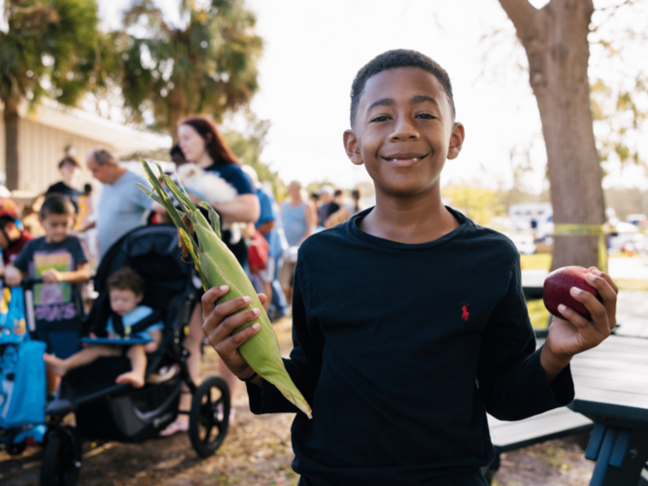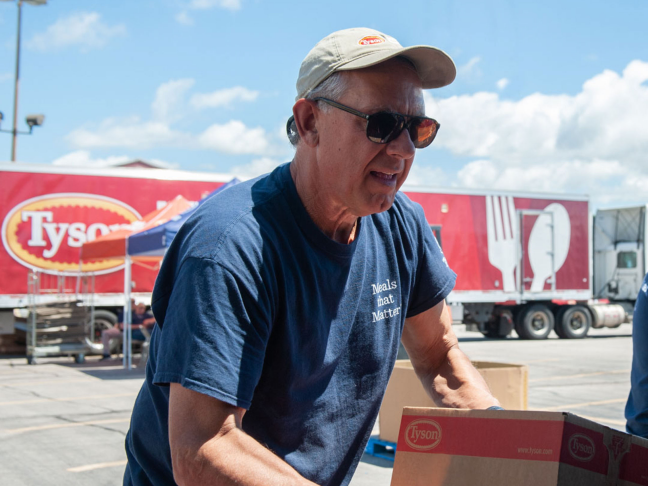Corporate Giving
Tyson Foods utilizes philanthropy as a lever to create value for our stakeholders, address systemic issues and strengthen the relationship between our operating locations and areas where our team members live. Tyson Foods has two philanthropic initiatives—Community Giving and Strategic Philanthropy.
Please check the calendar for updates to your grant application.
For all other inquiries, please reach out to corporategiving@tyson.com.
Tyson Foods is committed to helping the communities we serve thrive by strengthening relationships between our operating locations and the locations where our team members and their families live. We look to scale existing programs with positive outcomes for the communities in which we operate. Grant requests are funded between $500 and $5,000, prioritizing programmatic and geographic coverage and expanding the reach of services.
Note: Due to an increase in qualified applications, we have adjusted our funding levels to support a broader range of nonprofits.
Community giving is advised by our local operating locations, meaning that organizations must ensure they have a local Tyson Foods team member willing to vouch for their intended proposal. This allows our team members on the ground to have input in this process and provide insight into their community’s needs. If your community organization would like to secure financial resources and your organization meets the requirements listed in the program guidelines below, please follow the link to submit a grant application.
Funding Cycle |
Applications Due |
Approvals Communicated* |
|---|---|---|
|
CY25Q2 |
April 25, 2025 |
May 30, 2025 |
|
CY25Q3 |
July 25, 2025 |
August 29, 2025 |
|
CY25Q4 |
October 31, 2025 |
December 5, 2025 |
|
CY26Q1 |
January 30, 2026 |
March 6, 2026 |
Tyson Foods Strategic Philanthropy is designed to align with our goals and provide multi-year investments in areas that are material to our business:
1. Food access and nutrition — Tyson Foods continuously works to improve the nutrition, access and affordability of food, particularly in rural and urban food deserts. Our approach includes investments and strategic partnerships with hunger relief organizations like Feeding America®, a nationwide network of food banks. To join Feeding America in its efforts or to get involved with your local food bank, visit feedingamerica.org.
2. People and opportunity — Tyson Foods believes in cultivating opportunities for individuals to ultimately provide for themselves and their families. Our investment goes towards removing obstacles to obtaining and maintaining gainful employment and supporting individuals' growth in their careers.
Tyson Foods will pursue philanthropic contributions and opportunities that align with the portfolios mentioned above. We aim to invest in projects at the national level that also provide regional impacts.
If you have not heard directly from Tyson Foods about the strategic partnership opportunity, your organization is only eligible to apply for funding as a community giving partner.
To ensure an equitable process, we ask that your organization include all necessary details within your grant application. Tyson Foods Corporate Giving team will not meet with organizations prior to an application cycle. Please pitch your proposal to the local Tyson Foods facility and receive their buy-in/support. This is a required field within the grant application. Tyson Foods Corporate funds these requests at the recommendation of local Tyson Foods team members who are most knowledgeable about their communities’ needs. We encourage nonprofit pitches to include the following:
- Address a systemic issue within a Tyson Foods community that supports an underserved population
- Specify how the project, program or initiative will address the community’s issue(s) and the scale/reach of the proposal
- Detail a plan to measure the impact/success of the specific proposal through stories and metrics
- A willingness to engage and connect with the local Tyson Foods facility for buy-in
The Tyson Foods Corporate Giving team will take direction and recommendations from our plant operations regarding community giving. At the end of every quarter, the Tyson Foods Community Giving Steering Committee—made up of team members from across our enterprise—will review the backlog and prioritize investments that impact as many Tyson Foods communities as possible. We prioritize proposals that are programmatically and geographically diverse across our operational footprint.
Our Community Giving program operates on a quarterly funding cycle to give organizations four chances per year to receive funding. Organizations will be notified after each quarter if the proposal is being rejected or funded, so the partner won’t need to wait more than three months to have an answer about their application. If your organization's application is rejected, we welcome you to resubmit the following quarter.
Sponsorships - Request(s) for event support with high brand recognition. For questions, please email sponsorship@tyson.com.
Community Giving - Request(s) for programmatic support for a nonprofit organization within a Tyson Foods community, with local plant support/buy-in. For questions, please email corporategiving@tyson.com.
Product Donations - When all sales opportunities have been exhausted, and with careful consideration of all product dates before the maximum shelf life has expired, product will be donated to support food banks, food pantries and other organizations to help end food insecurity. For questions, please email productdonationrequest@tyson.com or see our Tyson Foods Product Donation Policy to learn more.
Please view our program guidelines and ensure you meet program requirements. Tyson Foods prioritizes the following:
- Programmatic and geographic diversity
- Requests from 501c3 nonprofits for specific proposals (no general funding or event-support requests)
- Local support/plant buy-in
- High impact/reach (number of people served, number of backpacks distributed, classes taught, increased staff, etc.)
- Clear and concise grant applications
List the issue your organization is addressing and provide details on the outcome and impact of the problem.
Example: “Food insecurity in XYZ community affects __% of adults, __% of children and __% of the elderly. This community is considered a food desert based on data from XYZ source that limits access to affordable and nutritious food. This problem disproportionately affects the XYZ community in this 7-county area with a food insecurity rate of __% and the poverty rate climbing above the national average at __%. Due to the food insecurity rates, this community has a high rate of chronic health issues, high unemployment, increased eviction rates, low literacy scores and school attendance records and high crime rates per XYZ sources.
Describe the program, project or initiative that this proposal will support and how it will address the issue(s).
Example: Additional funding of $____ will allow five more mobile pantry distribution sites for this area. More than 15,000 previously unserved citizens will now have access to nutritious and quality protein and produce. The funding will go towards purchasing this refrigerated van (a quote/invoice for the van is included). Tyson Foods will join XYZ partners and the committed funds from these partners (list other partners and funding amounts) to purchase the van. We plan to sustain this project by continuing our partnership with the area food bank and working with the local grocery stores to accept produce and protein. A portion of these proceeds will go towards administrative costs to run this program and upkeep/maintenance for the van. By investing in this mobile pantry, we are addressing the food insecurity rate within this food desert by providing a choice pantry style and leveraging volunteers from the local community to help with distribution. This also addresses this community's transportation barrier as we target neighborhoods with little to no transportation to access quality and nutritious food. The mobile pantry will provide culturally competent food items for the community and will provide 45-50lbs of groceries (list the items and how they are being obtained) every two weeks.
Determine how your organization will measure success. What does good look like? List the metrics and intended goals, outcomes and the impact of this proposal.
Example: The growth of this program will be considered successful if the food insecurity rate has been able to decrease by __%. Mobile pantries are a proven model of success, according to XYZ source. We will also measure success through a quarterly survey to better understand the needs of our neighbors and receive feedback about the pantry. We will distribute the survey via mail, QR codes and in-person when visiting the pantry. Our goal is to provide food to more than 1,000 households in this community through this program. We plan to measure the impact by gauging how many families are now being served than before and if other basic needs are affected by now having groceries provided every two weeks (provide examples, ie: “we can now pay the electric bill and have seen a decrease in my partners A1C due to healthier food options”). The survey will measure XYZ factors to inform our model better moving forward. We hope to have a 75% satisfaction rate through the survey and that each round of surveys will generate at least 50% written feedback. We intend to increase our food-sourcing partners by 10% throughout the program. Additionally, we want to ensure diversity in our food choices by having at least 15% of the previous week’s food options differ from the next week's. We also plan to source locally produced food items by partnering with area grocers and farmers. At least 25% of the food sourced will include sustainable packaging. Ultimately, we want residents to have a dignified and equitable experience and increase their overall access to healthy food options that are also culturally relevant by receiving and implementing feedback from our neighbors and through partnerships.
Sponsorships
Tyson Foods welcomes sponsorship proposals from organizations that align with the company’s core values and allow the company to play a vital role by funding visible contributions to the community. Submit proposals 90 days before expected advertising or promotion. For example, submit February sponsorships before November 1. The most competitive proposals should:
- Benefit the communities immediately surrounding our World Headquarters (WHQ) campus in Springdale, Arkansas
- Have community benefit statements and include:
- Who benefits from the funding requested?
- What is the benefit to that audience and the expected duration of that benefit?
- Outline the visibility of the event or project
- Show how funding will be leveraged to support the organization’s primary mission
- State what part of the requested funding will be tax deductible
Please email sponsorship@tyson.com with any questions, but submit all proposals using the below link.

To improve quality of life and to support communities where we live and work, we awarded $2.04 million to nonprofits and community efforts in FY23.

Tyson Foods committed $2.5 million to fight hunger in 2023. We partnered with Feeding America® member food banks to provide greater access to protein in communities facing food insecurity.

In 2023, we donated more than 40 million pounds of protein to regional food banks and community pantry partners nationwide. This equates to 120 million servings, 1,300 truckloads and more than 195,000 partners served.